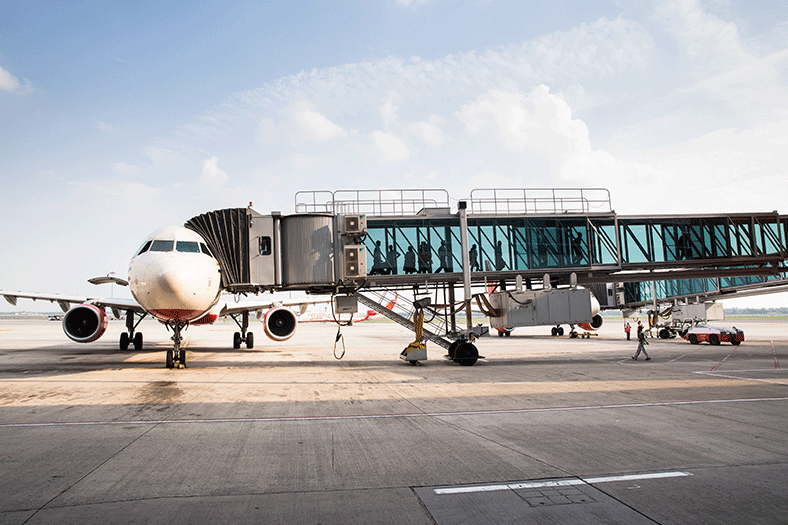The future is ‘contactless’

As the aviation sector gets ready to reboot, airports are now vying for contactless technologies and innovations to keep air travel safer, seamless and cherished in the long term.
When it comes to architecture and design of air terminals, bus terminals or railway terminals, it can be a complex affair. More so because the volume of the people using such facilities change over time. Though air travel is probably the most expensive among the three choices mentioned above, it hasn’t discouraged people to utilise airways as a convenient mode of transportation. This exponential growth of people (until now, owing to the pandemic) who fly by air has made it mandatory for most of the airports to revamp itself to accommodate more travellers.
Laura Ettelman, Managing Partner, SOM, says “Airports are a particularly complex project type. They are often massive in scale, and a lot of the time, they have to be built around an already active terminal. Aircraft design also advances very rapidIy, and that has made so many airports around the world become almost instantly obsolete. For these reasons, flexibility is extremely important, because not every existing terminal can easily adapt to new aircrafts without slowing down service. We have seen a lot of airports get demolished because they were not future-proofed in any way.”
On-site challenges are always there. Architects and designers brainstorm together with civic experts to address these challenges. The onset of the pandemic has however led to a new kind of challenge, even airports which have been upgraded are trying to come up with solutions to address the situation.
Derek A.R. Moore, Director, SOM says “At the airside, the fuselage width and seating configuration of the aircraft had already forced a proximity between people that was uncomfortable even before the pandemic, and right now, that proximity can be hazardous. While airlines are in near exclusive control of the conditions we experience in flight, we have the opportunity and responsibility to make airport terminals safe, healthy spaces. The changes that this will require start at the point of access. If we convert the terminal entrance into a health checkpoint, we can create flexible buffer zones.”
As domestic flights resume and air bubbles are being created for international flights to resume, the entire concept of safe air travel is getting revamped. Unlike earlier people are thinking twice before making an air travel, the primary concern being how is the aviation sector ensuring safety of the passengers and its staff. Airport operators are now gearing up to address the new challenges and the trust deficit which has set in. This phase is witnessing the infusion of additional technology in an effort to make processes “contactless”.
Pankaj Vatsa, Executive Director – Highways, Buildings and Aviation, Management, Egis India says “In today’s world where social distancing is a norm, airports also need to find ways to deploy digitization and automation to make things safe for both passengers and staff. The check-in process needs to be completely online. Automation must be explored and employed at every step wherever possible to reduce human touch. Systems should be used to predict and pre-empt the risks by scanning the people at the airport.”
In the wake of the current situation GMR Hyderabad International Airport has scaled up its NETC (National Electronic Toll Collection) FASTag Car Parking in collaboration with NPCI (National Payments Corporation of India) integrating 10 NETC FASTag Issuer banks and will go live with other issuer banks in the next few weeks. With this development, Hyderabad International Airport now offers India’s first and only fully contactless airport car parking experience for passengers and visitors. Pradeep Panicker, CEO, GHIAL, said, “As part of our commitment to providing a safe airport experience during Covid-19 pandemic, we are happy to announce that now passengers and visitors can avail a fully contactless car parking experience thanks to the collaboration with NPCI and NETC, which has now made our car parking fully compatible with any NETC FASTag Issuing Banks in India.”
Contactless’ is the buzzword at the Kempegowda International Airport, Bengaluru (KIAB or BLR Airport) as well. In an effort to protect passengers and staff from the risk of COVID-19 transmission, Bangalore International Airport Limited (BIAL) has introduced a Parking-to-Boarding contactless journey at BLR Airport. With greater emphasis on minimum touch and minimum exposure between passengers and airport personnel, BIAL aims to minimise all physical contact at the airport. The technology will continue to enable a seamless airport journey, with greater emphasis on health and safety.
“As the Gateway to a new India, BLR Airport has a key role to play in helping passengers through this global health crisis by reassuring them that their safety is our top priority. We have introduced innovative contactless procedures to minimise exposure at the Airport. These enhancements demonstrate our continued commitment to keep our passengers safe in this environment. We believe our new measures will boost confidence among passengers.” says Hari Marar, MD & CEO, BIAL.
Escalators and elevators transport a bulk of the passengers to different corners within an airport and they too have implemented technologies to make this transition safer for the airport staff and passengers.
Manish Mehan, CEO, thyssenkrupp Elevator (India) says “thyssenkrupp Elevator has launched forward-looking technologies for healthy and secured mobility experience at airports. To create a clean and healthy mobility solutions’ environment and ensure peace of mind for passengers, the company is focusing on three pillars: hygiene technologies, physical distancing, and touchless technologies to prevent infection in elevators, escalators and moving walks at airports and other public places. As we strive to make every elevator a healthy and disease free space, we have launched an advanced Air purification solution, LED thermal camera and aerosol disinfectant solution. Furthermore, to make escalator handrails free from any pathogens and to prevent the disease transmission at all times, we have launched a high intensity UV sanitizing unit. These units automatically sanitize every inch of the handrail on every pass, to make it safe for everyone.”
Likewise, Otis Elevators and Escalators too have taken steps to make airports safer for its staff and passengers. Sebi Joseph, President, Otis India says “Otis worked with the Ted Stevens Anchorage International Airport in the United States to install UV-C light escalator handrail sanitizers as part of its efforts to combat the spread of germs. Purification products are also in demand to promote hygiene in elevators and on escalator handrails reducing germs thereby improving conditions for passengers. Otis quickly brought to market a plasma purification fan for elevators, which uses an anion generator and ultraviolet lamp to kill germs and other microorganisms. For escalators and moving walks, antimicrobial handrails and a UV-C light handrail sanitizer are available now.”
As we move towards the future, a conscious effort will be made to revamp spaces which cater to a plethora of people. This was always needed in a country like India, not just in the airports but also in bus terminals and train terminals. Measures which were probably suggested by experts for proper crowd management during travelling as also safe travel, much earlier , will find a new voice. We only hope that the right solutions are implemented soon. It will save our lives and the lives of the subsequent generations which will follow.
Airports are a particularly complex project type. They are often massive in scale, and a lot of the time, they have to be built around an already active terminal.
Laura Ettelman, Managing Partner, SOM
At the airside, the fuselage width and seating configuration of the aircraft had already forced a proximity between people that was uncomfortable even before the pandemic, and right now, that proximity can be hazardous.
Derek A.R. Moore, Director, SOM
In today’s world where social distancing is a norm, airports also need to find ways to deploy digitization and automation to make things safe for both passengers and staff.
Pankaj Vatsa, Executive Director – Highways, Buildings and Aviation, Management, Egis India
thyssenkrupp Elevator has launched forward-looking technologies for healthy and secured mobility experience at airports.
Manish Mehan, CEO, thyssenkrupp Elevator (India)
Otis worked with the Ted Stevens Anchorage International Airport in the United States to install UV-C light escalator handrail sanitizers as part of its efforts to combat the spread of germs.
Sebi Joseph, President, Otis India
Cookie Consent
We use cookies to personalize your experience. By continuing to visit this website you agree to our Terms & Conditions, Privacy Policy and Cookie Policy.









